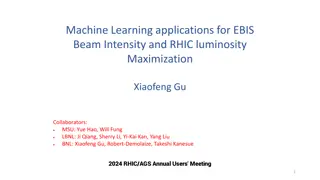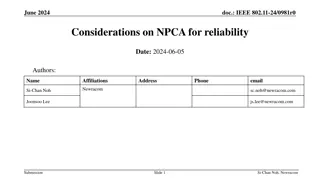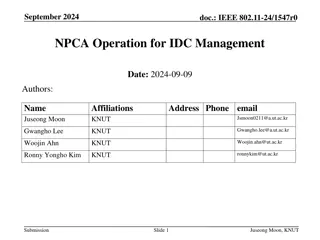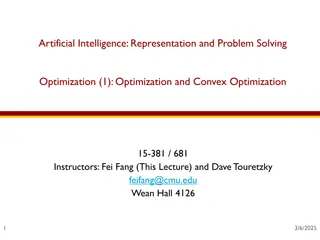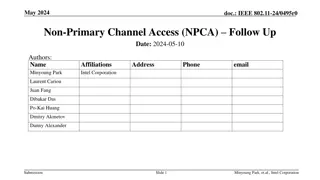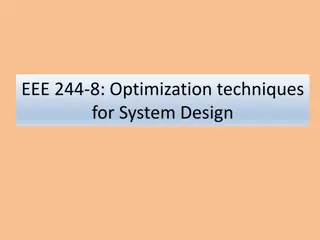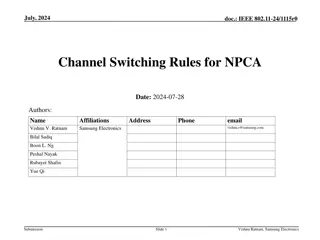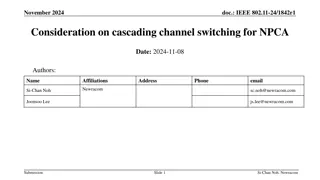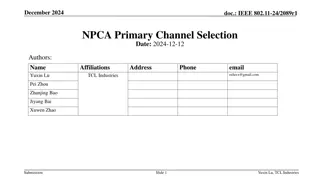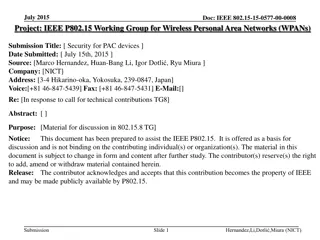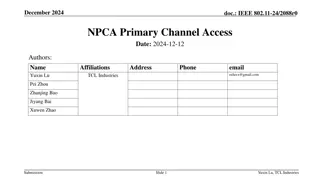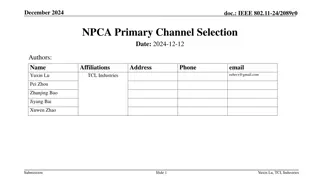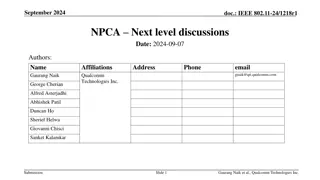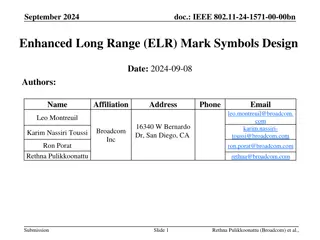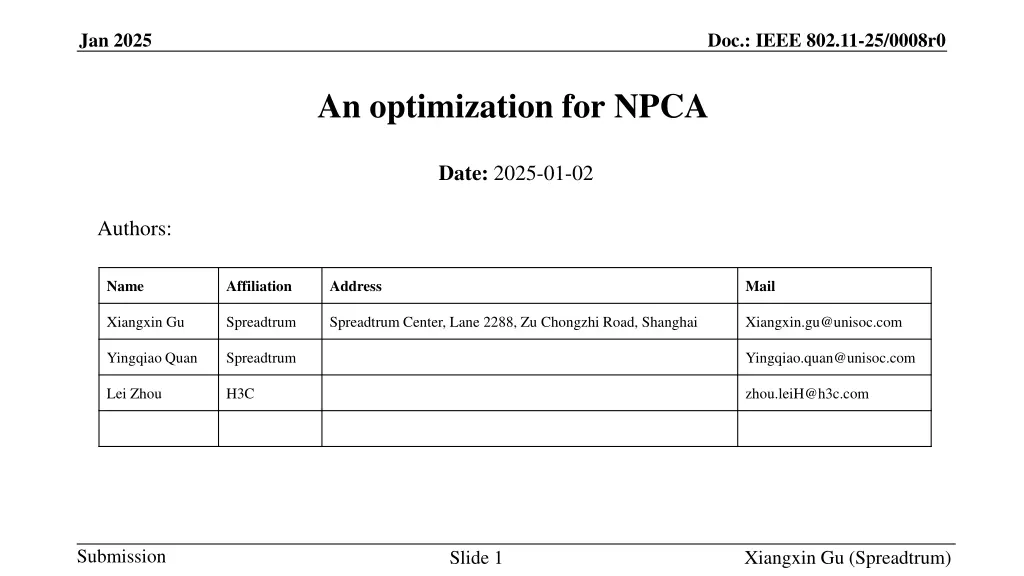
IEEE 802.11-25/0008r0 - Optimization for NPCA
Explore the progress and challenges in achieving Non-Primary Channel Access (NPCA) in IEEE 802.11-25/0008r0. Delve into conditions triggering channel switching, handling transmission failures, and proposed solutions involving CTS frames. Stay informed about advancements in wireless communication protocols for enhanced efficiency.
Download Presentation

Please find below an Image/Link to download the presentation.
The content on the website is provided AS IS for your information and personal use only. It may not be sold, licensed, or shared on other websites without obtaining consent from the author. If you encounter any issues during the download, it is possible that the publisher has removed the file from their server.
You are allowed to download the files provided on this website for personal or commercial use, subject to the condition that they are used lawfully. All files are the property of their respective owners.
The content on the website is provided AS IS for your information and personal use only. It may not be sold, licensed, or shared on other websites without obtaining consent from the author.
E N D
Presentation Transcript
Jan 2025 Doc.: IEEE 802.11-25/0008r0 An optimization for NPCA Date: 2025-01-02 Authors: Name Affiliation Address Mail Xiangxin Gu Spreadtrum Spreadtrum Center, Lane 2288, Zu Chongzhi Road, Shanghai Xiangxin.gu@unisoc.com Yingqiao Quan Spreadtrum Yingqiao.quan@unisoc.com Lei Zhou H3C zhou.leiH@h3c.com Submission Slide 1 Xiangxin Gu (Spreadtrum)
Jan 2025 Doc.: IEEE 802.11-25/0008r0 Recap TGbn defines a mode of operation that enables a STA to access the secondary channel while the primary channel is known to be busy due to OBSS traffic or other TBD conditions. The mode of operation shall not assume that the STA is capable to detect or decode a frame and obtain NAV information of the secondary channel concurrently with the primary channel. A BSS shall only have a single NPCA primary channel (name TBD) on which the STA contends while the primary channel of the BSS is known to be busy due to OBSS traffic or other TBD conditions. An NPCA STA shall initiate frame exchange on the NPCA Primary channel with an NPCA Initial Control Frame in the non-HT PPDU or non-HT duplicate PPDU format using a rate of 6 Mb/s, 12 Mb/s, or 24 Mb/s Details on NPCA ICF are TBD The event that triggers switching to the NPCA primary channel shall be OBSS Control frame exchange (e.g., (MU-)RTS/CTS) or OBSS HE/EHT/UHR PPDU Note: Other conditions TBD We have made a good progress on NPCA. This contribution provides one possible condition to trigger switching to the nonprimary channel. Submission Slide 2 Xiangxin Gu (Spreadtrum)
Jan 2025 Doc.: IEEE 802.11-25/0008r0 Issues in NPCA A STA that accesses the BSS primary channel and transmits to its associated AP will encounter transmission failure and invoke error recovery procedure during the AP switch to the NPCA primary channel. The STA may access the BSS primary channel subject to its location . The transmission failure may even lead to the STA downgrading its transmission rate. NPCA transmission may fail if there is a STA accessing the BSS primary channel with BW overlapping NPCA channel. Same scenario as previous one. The target STA of an NPCA transmission may not be on the NPCA primary channel. With ICF on the NPCA channel first, more questions: What s the next behavior if no ICR received ? How to set the duration field in ICF ? Submission Slide 3 Xiangxin Gu (Spreadtrum)
Jan 2025 Doc.: IEEE 802.11-25/0008r0 Solution nonprimary The AP decides to switchto the nonprimary channel channel Primary channel NPCA TRANSMISSION Switch back to primary channel OBSS PPDU Mhz 20 CTS The AP does not need to switch its LO frequency actually. The AP sends a CTS frame on the BSS primary 20 MHz with limited TX power, if the least NPCA switching delay gives the AP the chance. To block STAs not switching to the NPCA primary channel from sending to the AP. To indicate NPCA STAs to switch to the NPCA primary channel. A reserved bit in CTS can be used to the indication. The CTS has little harm to the OBSS PPDU transmission. Submission Slide 4 Xiangxin Gu (Spreadtrum)
Jan 2025 Doc.: IEEE 802.11-25/0008r0 SP Do you agree to that the AP sends a CTS frame on the BSS primary 20 MHz channel at the time it decides to switch to the NPCA primary channel if the least switching delay gives the AP the chance? The CTS frame is to block STAs not switching to the NPCA primary channel from sending to the AP. The CTS frame is to indicate NPCA STAs to switch to the NPCA primary channel. Submission Slide 5 Xiangxin Gu (Spreadtrum)
Jan 2025 Doc.: IEEE 802.11-25/0008r0 References [1] 11-24-0171-25-00bn-tgbn-motions-list-part-1.pptx Alfred Asterjadhi [2] 11-24-1762-13-00bn-pdt-mac-npca.docx Matthew Fischer Submission Slide 6 Xiangxin Gu (Spreadtrum)





